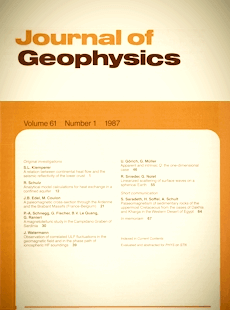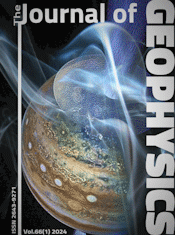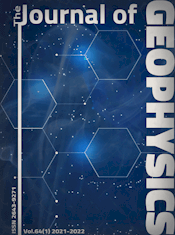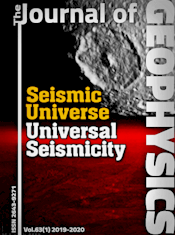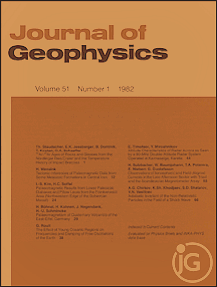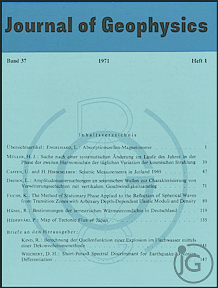A paleomagnetic cross-section through the Ardenne and the Brabant Massifs (France-Belgium)
Article Sidebar
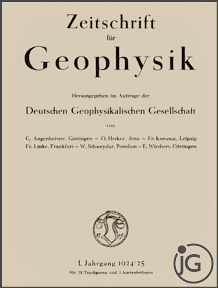
Vols. 1-18 (1924-1944), ISSN 0044-2801
Main Article Content
Abstract
In order to constrain the motions of the allochthonous Ardenne during the Paleozoic, standard paleomagnetic techniques have been applied on acidic and basic sills of the Cambrian Rocroi massif and on Cambrian-to-Visean sedimentary series sampled along the Meuse valley. Ordovician–Silurian volcanics and Devonian–Visean limestones have also been collected in the autochtonous Brabant and Namur basin, in order to get paleomagnetic reference poles. In the Ardenne, two groups of in situ paleomagnetic directions arise. The A components (mean: D = 212°, I = -11°, α95 = 6°, for 10 sites), that are characterized by unblocking temperatures around 330° C, represent Late Variscan (Stephanian–Permian) overprints. The B components (mean: D = 236°, I = 2°, α95 = 11°, for 13 sites) display higher unblocking temperatures, in the range 400°-580° C. They show a large scatter in inclination (–25° < I < 35°) that is not reduced by tectonic correction. The B components are interpreted as post- and partly synfolding overprints of Middle-Late Carboniferous age. In the Brabant, all series display Late Variscan remagnetizations (mean: D = 204°, I = -7°, α95 = 9°, for 5 sites), consistent with the Stephanian- Permian pole of Europe. The existence of Middle-to-Late Variscan B directions in the Armorican Massif, Central Massif, Vosges and Black Forest indicates that in Namurian–Westphalian times the whole investigated Variscan belt, including the Ardenne, was trending N-S. A 45° clockwise rotation relative to the paleomeridian, during the latest Westphalian–Stephanian, has lead the massif to its Permian position.
 ARK: https://n2t.net/ark:/88439/y010025
ARK: https://n2t.net/ark:/88439/y010025
Permalink: https://geophysicsjournal.com/article/140
Article Details
References
Andre, L., Deutsch, S. (1984) Les porphyres de Quenast et de Lessines: Geochronologie, Geochimie isotopique et contribution au probleme de l'age du socle precambrien du massif de Brabant (Belgique). Bull. Soc. Beige Geol. 93:375-384
Andre, L., Deutsch, S., Michot, J. (1981) Donnees geochronologiques concernant le developpement tectono-metamorphique du segment caledonien braban~on. Ann. Soc. Geol. Belgique 104:241-253
Bachtadse, V. (1983) Palaeomagnetic evidence for Hercynian rotations of Central Europe. Terra Cognita 3:239
Berthold, G., Nairn, A.E.M., Negendank, J.F.W. (1975) A palaeomagnetic investigation of some of the igneous rocks of the SaarN ahe basin. N. Jb. Geol. Palaeont. 43:134-150
Beugnies, A. (1962) Le massif cambrien de Rocroi. Bull. Serv. Carte Geol. France
Beugnies, A. (1983) Structure de l'aire anticlinale de l'Ardenne a l'Ouest du meridien de Libramont. Ann. Soc. Geol. Nord, CII:165-173
Dandois, P. (1981) Diagenese et metamorphisme des domaines caledonien et hercynien de la vallee de la Meuse entre CharlevilleMezieres et Namur (Ardennes franco-belges). Bull. Soc. Beige Geol. 90:299-316
Donsimoni, M., Feys, R., Greber, C. (1980) Bassins carboniferes. In: Megnien (Ed.) Synthese geologique du Bassin de Paris, Mem. B.R.G.M. 101, 1, C.:22-24
Duff, B.A. (1980) The palaeomagnetism of Jersey volcanics and dykes, and the Lower Palaeozoic apparent polar wander path for Europe. Geophys. J. R. Astron. Soc. 60:355-375
Ecors-Information (1984) Etude de la croute terrestre en France par methode sismique. l.F.P., 1.N.A.G., S.N.E.A.P.(P), CNEXO, Lettre 2
Edel, J.B. (1984) Etude paleomagnetique du Nord du Massif Central. In: Programme Geologie Profonde de la France. Th. 2, Documents B.R.G.M. 81-2:45-60
Edel, J.B. (1985) Magnetisme et paleomagnetisme des roches du socle au Sud de l'anomalie magnetique du Bassin de Paris. In: Programme de Geologie Profonde de la France, Th 2, Documents B.R.G.M. 95-2:17-27
Edel, J.B. (1986) Paleopositions of the western Europe Hercynides during the late Carboniferous deduced from paleomagnetic data. Consequences for "Stable Europe", Tectonophysics (In press)
Edel, J.B., Coulon, M. (1984) Late Hercynian remagnetization of Tournaisian series from the Laval syncline-Armorican MassifFrance. Earth Planet. Sci. Lett. 68:343-350
Edel, J.B., Lacaze, M., Westphal, M. (1981) Paleomagnetism in the northeastern Central Massif (France): evidence for Carboniferous rotations of the Hercynian orogenic belt. Earth Planet. Sci. Lett. 55:48-52
Edel, J.B., Montigny, R., Royer, J.Y., Thuizat, R., Trolard, F. (1986) Paleomagnetic investigations and K-Ar dating of the Variscan plutonic massif of the Champ du Feu and its volcanic-sedimentary
environment, northern Vosges, France. Tectonophysics 122:165-185
French, R.B. (1976) Lower Paleozoic paleomagnetism of the North American craton. Ph.D. thesis, The University of Michigan, Ann Arbor
Kolesov, Y. V. (1984) Paleomagnetic stratigraphy of the Devonian-Carboniferous Boundary Beds in the Soviet North-East and in the Franco-Belgian Basin (Short Note). Ann. Soc. Geol. Belgique 107:135-136
Kruczyk, J. (1983) Phase transitions in iron oxides and sulphides and their relations to magnetic properties of rocks. Polish. Acad. Sci. Pub. Inst. Geophys. C-15 (164), 92 pp.
McClelland Brown, E. (1983) Palaeomagnetic studies of fold development and propagation in the Pembrokeshire Old Red Sandstone. Tectonophysics 98:131-149
Michot, J. (1976) Geochronologie du paleozo'ique en Belgique (Abstract). 4e Reunion Ann. Sci. Terre, Paris, p.295
Molyneux, L. (1971) A complete result magnetometer for measuring the remanent magnetization of rocks. Geophys. J.R. Astron. Soc. 24:429-433
Nijenhuis, G.H.W. (1961) A palaeomagnetic study of the Permian volcanics in the Nahe region (SW Germany). Geol. Mijnbouw 40:26-38
Pique, A., Huon, S., Clauer, N. (1984) La schistosite hercynienne et le metamorphisme associe dans la vallee de la Meuse, entre Charleville-Mezieres et Namur (Ardennes franco-belges). Bull. Soc.
Beige Geol. 93:55-70
Westphal, M. (1976) Contribution du paleomagnetisme a l'etude des deplacements continentaux autour de la Mediterranee occidentale. These Doct. Etat, Univ. Strasbourg I, 300 pp.


